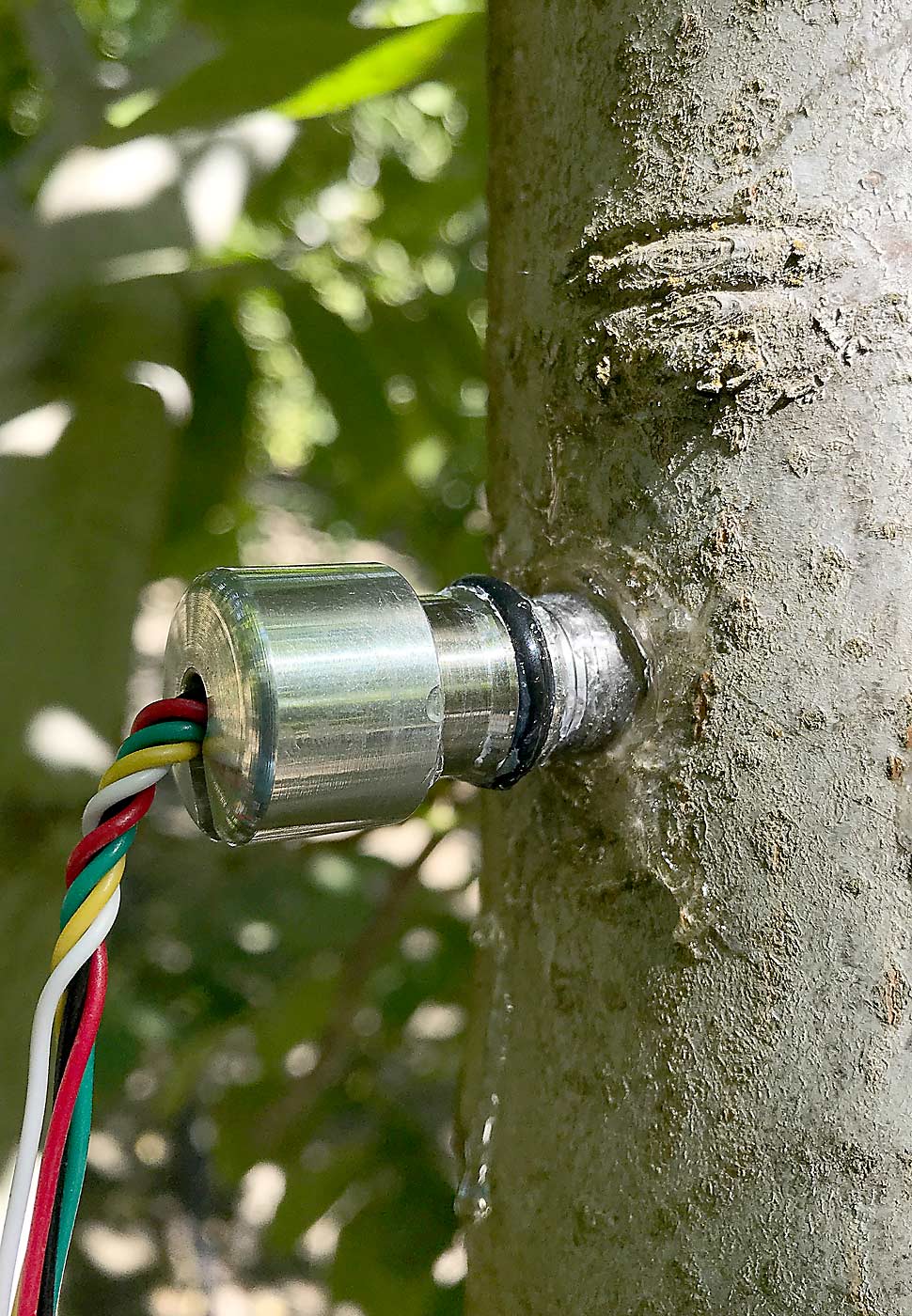More accurate assessments for when growers should irrigate, and how much
Published on by Water Network Research, Official research team of The Water Network in Technology
A new sensor technology developed at Cornell University plugs into a tree or vine to read stem water potential in real time, replacing weekly pressure chamber measurements for guiding irrigation management, according to retired physiologist Alan Lakso, who now works with the company created to commercialize it. (Courtesy FloraPulse)
Imagine the perfect irrigation sensor.
University of California, Davis professor and irrigation expert Ken Shackel knows what it should measure.
“If I irrigate more, will I get more profit? Or less profit? Everything else is incidental to what you are trying to accomplish,” Shackel said in a talk at the Washington Winegrowers Association’s annual meeting in March. “But we don’t have a sensor that measures that economic effect.”
Until then, new gizmos and apps continue to roll out every year, each taking a slightly different approach to tell you how thirsty your vines are. They promise to help growers save water, improve fruit quality and someday provide a tool to show regulators that growers are irrigating as sustainably as possible.
“It’s a different mindset for irrigation scheduling,” Shackel said. “You ask the plant, ‘How do you feel?’ and then you adjust your schedule to make the plant feel what you want it to feel.”
There’s no perfect sensor yet, but tech-curious growers have plenty to consider. Before deciding what technology to try, ask yourself what you want it to tell you. Some approaches primarily tell you when to irrigate, while others tell you how much.
When?
To ask the plant directly how thirsty it feels, Shackel said, growers and researchers rely on pressure chamber measurements of stem or leaf water potential. That measures how hard the plant has to work to pull water from the soil.
But it’s far from automated; someone has to haul it to the field once a week to record data.
“It’s like trying to play the stock market when you can only get data when you close on Friday,” said longtime Cornell University physiologist Alan Lakso, who spent years working on a sensor that could be embedded in a vine or tree to measure the stem water potential in real time.
Now retired, Lakso, Cornell engineer Abe Stroock and his former graduate student, Michael Santiago, have since formed a company, FloraPulse, to commercialize the microtensiometer they designed. They sold it to a limited number of customers this year, CEO Santiago said, with full service for $1,500 per installation per year. So far, wine grape, almond and stone fruit growers in California have expressed interest, but the technology is not yet commercially available in Washington.

To get a direct measurement of plant water stress, not just a response to that stress, you have to go directly to the plant, Lakso said, but then you have to contend with the plant’s response to the installed sensor, including gummosis in stone fruit trees. (Courtesy FloraPulse)
The data comes in the form of an app that plots daily stem water potential against thresholds based either on recommendations from UC Davis for almonds or prunes or by working with wine grape growers to set their own, Santiago said.
“We believe automated irrigation is coming and we’re going to be a part of that,” he said. “Growers could save a lot of water, and what we’re doing really fits in well with the way water management is going, at least in California.”
Taking measurements directly inside the vine has pros and cons. On the plus side, direct measurements eliminate the need to account for any other correlated factors, Lakso said. The challenge lies in keeping an electronic sensor reliable in a wet environment, inside a trunk that’s swelling and shrinking in response to temperature and photosynthesis.
The sensors themselves perform very reliably, but the installations can fail if the plant responds by gumming up around the wound, as some stone fruit does, he said. To account for that, FloraPulse currently installs two sensors in the same vine, so that if there is a failure, it’s easy to catch, Santiago said.
Taxonomy
- Water Monitoring
- Crops